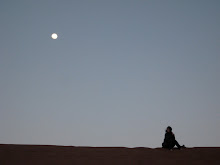
Published HERE at Artcritical.com
Xavier Cha’s “Body Drama” may take up the entire lobby gallery space at the Whitney Museum, but it is a small work, expertly pointed in concept. Cha distills contemporary experience into a single note about incompleteness, using the most obvious “problem” of today’s performance—the essential dissonance between video and liveness—as a starting point. Instead of trying to solve the clash, Cha highlights it, shaking up oil and water in order to mimic the vantage point of an individual in the midst of contemporary art and the greater world, conglomerates impossible to see as a whole, to fully know or even think you know.
Without belaboring the point, Cha uses simple techniques to point out a very current strain of emptiness and isolation, born and bred in the information age. Every hour on the hour, an actor steps into the gallery space with a video camera strapped into a harness that is secured around his or her waist. The “SnorriCam,” a device commonly used in horror films, is attached to a short rod that positions its eye to squarely frame the actor’s face. The camera films the actor emote for 20 minutes; museum visitors can see the live action, but there is no live feed to compare one’s view to the image captured by the camera. The most noticeable thing about the live performance portion of this piece is the fact that although the actors, in turn, each work hard to express the psychological terror of being alone in an unknowable place—Cha’s direction to them—there is little to no actual emotional content resulting from their efforts. Stripped of story, distanced by the camera device strapped on, and sanitized as intellectual content, the acting itself does not compel its audience to connect to the performer in the way we are generally intended to in the theater.
Twenty minutes after each hour, a museum employee walks into the space, turns off the camera attached to the actor, and they both exit the room. At the same moment, a video appears on an island of a wall in the center of the space. It’s almost impossible not to be immediately distracted by the video and miss the actor’s exit. Such seamlessness in choreographing attention is surprising in this context, and intriguing. On the screen, we see taped footage of a different actor in the gallery. This actor is not present, but with access to the filmed footage, we sometimes catch glimpses in the background of viewers who did see the particular live performance on different day in the same room this summer. After the transition, the work loses steam. It’s more difficult to watch an extended portion of overacting on video out of context, than it is to sit through the same thing live. But this conceptually grounded performance piece is about the transitions—each section feels less than enough, leaving a viewer wanting.
In Trisha Brown’s solo “Homemade” (1965), the artist moved with an 8mm projector attached to a similar device around her waist that projected, behind her onto the wall, a video (shot by Robert Whitman) of the same movements that she was making during the live performance. The duel images—live and on video— of Brown moving her body parts and attempting to strip the physical actions of associative emotion, conveyed, and still conveys in re-performances, hopefulness for democracy and the possibility of wider, more fully realized individual views. It is fueled with the energy of collaboration across genres and the excitement of newly minted postmodern dance, which liberated the performing body and presented him or her as a complete person. Now, after all the years in between, Cha uses a comparable formal technique to criticize museum visitors’ technology-riddled blindness to their own and others’ inner lives. Distance, dissatisfaction, and an inability to connect—that’s the heart of it.


